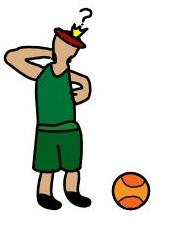|
Basic Basketball Rules All you need to know to play
If you are a Beginner to Basketball you will need to know the Basic Basketball Rules and luckily for you there may be some things you already know. This page will lay down the basics in order for you to play the first game.
The Aim of the Game When you play basketball, you play on a surface called a Court with 2 symmetrical halves, both consisting of a basket or net on each end. The aim of the game is to score the most points or baskets in the allotted time.
Click here to find your nearest court where you can master basic basketball rules. Teams You can play in teams which can consist of 1 to 5 players however you can also play on your own as well when practising or executing Drills. Playing with friends can be useful to help share advise and have more opportunities to learn and easily begin to understand basic basketball rules through playing regularly.
Positions Each player has his or her own position name on the court and this is usually determined by height, speed and agility. The tallest players are usually allocated Centre position, and they are usually available to rebound both defensively and offensively as well as being the best player for tip off. These players in the NBA can range from 6ft,7 to 7ft+ The next tallest players are usually Forwards and the fastest of these are called Power forwards. The smallest players are called Guards who are usually the quickest, both physically and mentally and who co-ordinate all the plays laid down by the coach of the team.
Basic Rules When moving the basketball around the court, the players must travel around using a technique called Dribbling. To dribble the player must not take more than a step and a half without the ball coming into contact with the court and back to the players’ hand again in a bouncing motion. If more than 1 and a half steps are taken this is a Travelling violation. Once the player has stopped dribbling they may not move again until the ball comes to them from another player. Each shot taken can be done either inside or outside the shooting Area. Outside the shooting area a successful shot is worth 3 points and inside the area is worth 2 points. However inside the shooting area, there is an area named The key in which players may not remain for More than 3 seconds to prevent goal hanging. Additional single points can be scored from the free throw line in a penalty. These are all basic basketball rules and there are many others that need to be obeyed in order not to violate the rulebook but as a beginner are not necessary to learn until you have mastered the basics.
Violations and Fouls When you begin to play basketball as a beginner, you are more likely to commit violations. This is nothing to worry about as the more you practise the more you gain a feel for Basic Basketball Rules. Violations like in any sport occur when a player does something which conflicts with the rulebook. After a violation the other team will become in possession of the ball. Double dribble is a violation, which involves a player dribbling the ball, stopping, and then dribbling again. As mentioned above,Travelling is also a violation. It is similar to double dribble but isn't the same and can be described as an incorrect dribble involving too many steps between a bounce. If the ball is above your hand when dribbling and you hand comes from underneath and over it to push it back down this is called Carrying as the players hand must always be above the ball when dribbling. A foul is committed when a player unlawfully makes contact with a player on the other team. There are two types of foul, which can result in a player getting a personal foul marked against them. Offensive fouls involve the offensive player knocking into the defender unnecessarily. Defensive fouls, are when defenders block, push, hit, or trip, up an offensive player.
|



